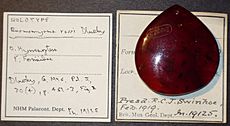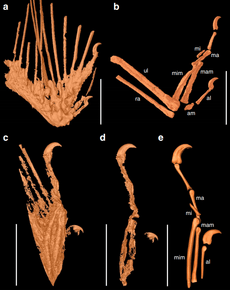Burmese amber fossils facts for kids
Burmese amber, also known as Burmite or Kachin amber, is a special type of amber found in the Hukawng Valley in northern Myanmar. It is very important because it contains amazing fossils from the earliest part of the Upper Cretaceous period, about 99 million years ago. People have been collecting this amber for a very long time, since the first century AD. The mining of this amber has sometimes been linked to conflicts in the area.
This amber is like a time capsule, preserving ancient flora (plants) and fauna (animals). It's especially famous for its arthropods, which are creatures with exoskeletons like insects and arachnids. But it also holds fossils of birds, lizards, snakes, frogs, and even tiny pieces of dinosaurs!
Contents
What Makes Burmese Amber Special?
Burmese amber is unique because of its age and the incredible variety of life it has preserved. It gives scientists a rare peek into what life was like almost 100 million years ago.
Ancient Creatures Trapped in Time
The amber has captured many different kinds of animals, giving us clues about ancient ecosystems.
Spiders and Other Arachnids
Many types of arachnids have been found in Burmese amber. These include:
- Over 40 different families of spiders.
- Many families of mites and ticks.
- Creatures like Opiliones (also called harvestmen or daddy longlegs).
- Other interesting arachnids such as scorpions and pseudoscorpions.
Insects from the Cretaceous Period
A huge number of insects are preserved in this amber. Scientists have identified many orders and families, including:
- More than 50 families of Hymenoptera (like ants and wasps).
- Almost 50 families of flies (Diptera).
- Nearly 90 families of beetles (Coleoptera).
- Many families of Neuroptera (such as lacewings and antlions).
- Over 60 families of Hemiptera (true bugs).
- Various types of Dictyoptera (like cockroaches and mantises).
Other Small Invertebrates
Besides arthropods, other small invertebrates (animals without backbones) have been found:
- Tiny nematodes (roundworms).
- Nematomorpha (horsehair worms).
- Small molluscs (like snails or slugs).
Vertebrate Discoveries
Perhaps the most exciting finds in Burmese amber are the vertebrates (animals with backbones). These are much rarer to find preserved in amber.
Dinosaur and Bird Fossils
- Scientists found a well-preserved theropod dinosaur tail, complete with its feathers! This was an amazing discovery.
- Fossils of ancient birds called Enantiornithes have been found. These include young birds, parts of wings, and feet. One special bird found here is named Elektorornis.
- A complete skull of a very unusual bird or lizard called Oculudentavis was also discovered.
Frogs, Snakes, and Lizards
- Electrorana is a very well-preserved frog found in the amber.
- An embryonic snake (a snake still developing in its egg) was also found, which is incredibly rare.
- Several types of lizards have been described, including a gecko called Cretaceogekko with its special toe pads still visible.
- One fossil that was first thought to be a chameleon turned out to be an albanerpetonid amphibian, a type of ancient salamander-like creature.
Images for kids





